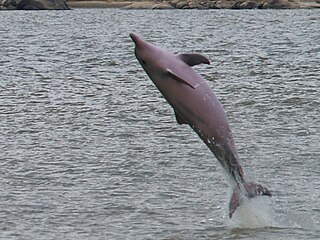
Perch is a common name for freshwater fish from the genus Perca, which belongs to the family Percidae of the large order Perciformes. The name comes from Greek: πέρκη, romanized: perke, meaning the type species of this genus, the European perch.

The grass warblers are small passerine birds belonging to the genus Locustella. Formerly placed in the paraphyletic "Old World warbler" assemblage, they are now considered the northernmost representatives of a largely Gondwanan family, the Locustellidae.

The river warbler is an Old World warbler in the grass warbler genus Locustella. It breeds in eastern and central Europe, and into the western Palearctic. It is migratory, wintering in inland southern Africa, from around the Zambezi River south to the vicinity of Pretoria in South Africa. The genus name Locustella is from Latin and is a diminutive of locusta, "grasshopper". This refers to the song of the common grasshopper warbler and some others in this genus. The specific fluviatilis is Latin for "of a river".

The tucuxi, alternatively known in Peru bufeo gris or bufeo negro, is a species of freshwater dolphin found in the rivers of the Amazon basin. The word tucuxi is derived from the Tupi language word tuchuchi-ana, and has now been adopted as the species' common name. Despite being found in geographic locations similar to those of 'true' river dolphins such as the boto, the tucuxi is not closely related to them genetically. Instead, it is classed in the oceanic dolphin family (Delphinidae).

The European perch, also known as the common perch, redfin perch, big-scaled redfin, English perch, Euro perch, Eurasian perch, Eurasian river perch, Hatch, poor man's rockfish or in Anglophone parts of Europe, simply the perch, is a predatory freshwater fish native to Europe and North Asia. It is the type species of the genus Perca.

The European river lamprey, also known as the river lamprey or lampern, is a species of freshwater lamprey.

Lemanea is a genus of freshwater red algae, in the order Batrachospermales. Both species are considered to be widespread in the northern hemisphere. Although placed in the Rhodophyta it in fact is green in colour.
Abergasilus amplexus is a species of parasitic copepod endemic to euryhaline habitats in New Zealand. It is the only known species in the genus Abergasilus.

Theodoxus fluviatilis, common name the river nerite, is a species of small freshwater and brackish water snail with a gill and an operculum, an aquatic gastropod mollusk in the family Neritidae, the nerites.

The little ground tyrant is a species of bird in the family Tyrannidae, the tyrant flycatchers and is the only species placed in the genus Syrtidicola. It is found in Amazonian Brazil, Peru, and Bolivia; also smaller regions of Colombia and Ecuador. Its natural habitats are subtropical or tropical moist shrubland and rivers.

Neogobius is a genus of goby native to Black Sea and the Caspian Sea basins. It is part of the broader Benthophilinae subfamily which is also endemic to the same region. Nevertheless, two Neogobius species have recently turned out to be highly invasive and spread across Europe and even to the Great Lakes of North America.

Theodoxus is a genus of nerites, small water snails with an operculum, some of which live in freshwater, and some in both freshwater and brackish water, aquatic gastropod mollusks in the family Neritidae, the nerites.

Boto is a Portuguese name given to several types of dolphins and river dolphins native to the Amazon and the Orinoco River tributaries. A few botos exist exclusively in fresh water, and these are often considered primitive dolphins.

The dolphin genus Sotalia is considered to have two member species with the classification of Sotalia guianensis as a distinct species from Sotalia fluviatilis in 2007. This was a result of recent morphometric analyses, as well as mitochondrial DNA analysis.

Hypsibius is a genus of tardigrades in the class Eutardigrada.

The Guiana dolphin, also known as the estuarine dolphin or costero, is a dolphin found in the coastal waters to the north and east of South America, and east of Central America. It is a member of the oceanic dolphin family (Delphinidae). It can live in both saltwater and freshwater.

Echiniscus is a genus of tardigrades in the family Echiniscidae. The genus was named and described by Karl August Sigismund Schultze in 1840.
Archechiniscus is the only genus of tardigrades in the family Archechiniscidae. It was first described by Erich Schulz in 1953.

Macrobiotus is a genus of tardigrade consisting of about 100 species.
Mesobiotus is a genus of tardigrades belonging to the family Macrobiotidae.














